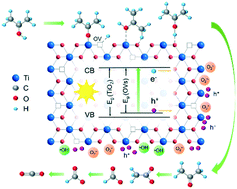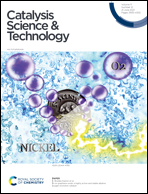TiO2 with controllable oxygen vacancies for efficient isopropanol degradation: photoactivity and reaction mechanism†
Abstract
Controlling the stoichiometry of reduced titanium dioxide (TiO2−x) is an effective strategy to modulate its surface chemistry and improve its charge separation. Here we applied a one-step flame synthesis method to fabricate defective TiO2−x nanoparticles with sizes of ca. 13 nm and a high specific surface area (SSA) of 110–130 m2 g−1. TiO2−x particles with a moderate number of defects and more grain boundary (GB) oxygen vacancies (OVs) exhibit an improved charge separation, leading to a remarkable degradation efficiency of gaseous isopropanol (IPA). The mineralization yield of the best-performing sample reaches 22.7% in 6 h under visible light and 98.8% in 70 min under UV-vis irradiation. The roles of O2˙−, h+ and ˙OH radicals in the steps of IPA degradation were systematically investigated. In situ diffuse reflectance infrared Fourier-transform spectroscopy (DRIFTS) reveals that surface OVs can greatly promote the dissociative adsorption of IPA to isopropoxides. Formate and acetate species are found to be the key reaction intermediates and the conversion of these two compounds to CO2 molecules is the rate-limiting step for the IPA degradation. The reaction mechanisms of IPA photo-oxidation on TiO2−x with different numbers and locations of defects are elucidated. This sheds more light on the “structure–activity” correlations and benefits the design of photocatalysts for efficient gaseous pollutant removal.



 Please wait while we load your content...
Please wait while we load your content...